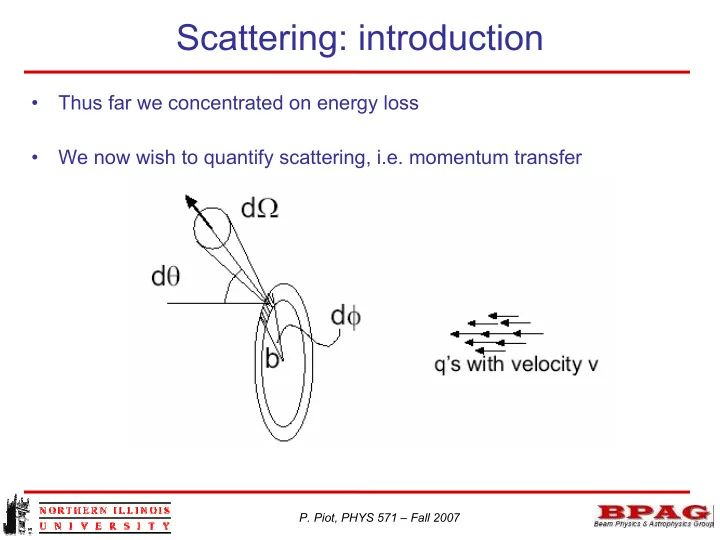

Scattering: introduction • Thus far we concentrated on energy loss • We now wish to quantify scattering, i.e. momentum transfer P. Piot, PHYS 571 – Fall 2007
Differential cross-section I • Let N ’ be the number of particles scattered from bdbd φ into the solid angle d Ω per unit of time. • Then bdb = (cos θ d ) • Where σ ϕ d bdbd ≡ Ω Ω d d is the differential cross-section P. Piot, PHYS 571 – Fall 2007
Differential cross-section II • Under the small-angle approximation we have: d σ = d Ω • Then • For e- we saw that • So • This is a small-angle approximation of the Rutherford differential cross section P. Piot, PHYS 571 – Fall 2007
Differential cross-section III • For electrons targets: • For nuclei targets Therefore scattering by nuclei is Z 2 more probable that • scattering by electron target. But there are Z times more nuclei than e- ⇒ scattering by • nuclei is Z times more probable that by e- • So scattering in a block of matter is dominated by nuclei (while energy loss is dominated by the electrons) P. Piot, PHYS 571 – Fall 2007
Remarks on Rutherford Cross section • The Rutherford cross section is actually: 2 σ 2 d Z Z e 1 ≡ 1 2 Ω θ 4 d 4 E sin ( / 2 ) • Which we could have inferred from a detailed analysis of the scattering geometry, wherein the impact parameter is actually related to the angle via 2 Z Z e 1 b = 1 2 θ 2 E tan( / 2 ) While we only had a 1/ θ dependence • • This is an historical conincidence that the Rutherford cross section which was derived in the framework of classical mechanics keep the same form in Quantum mechanics (when spin effects are introduced). P. Piot, PHYS 571 – Fall 2007
rms scattering angle I • When we have an incoming cloud of particle, e.g. a charged particle beam, how do we quantify the scattering? • Use statistical concept: the variance: if a variable x is distributed with a probability function F(x) then the variance of the function which is an indication of the spread of the variable x is ∫ ∫ − 2 F ( x ) x dx F ( x ) xdx 2 ≡ x ∫ F F ( x ) dx • Correspondingly the rms value is defined as 1 / 2 σ x ≡ 2 x P. Piot, PHYS 571 – Fall 2007
rms scattering angle II • Evaluating the integral for the d σ /d Ω we have • Thus for single event scattering • Where we can estimate a: atomic radius P. Piot, PHYS 571 – Fall 2007
Case of many small angle scattering • The charge q performs a random walk through the material and the rms deflection angle is given by • So that • And from central-limit theorem we infer the probability distribution to be P. Piot, PHYS 571 – Fall 2007
Case of single scattering events • Consider the single scattering event cross-section: • Introducing the projected angle • Upon integration over φ we get P. Piot, PHYS 571 – Fall 2007
Scattering probability P. Piot, PHYS 571 – Fall 2007
Summary (extract from the PDG) http://pdg.lbl.gov/ P. Piot, PHYS 571 – Fall 2007
Recommend
More recommend